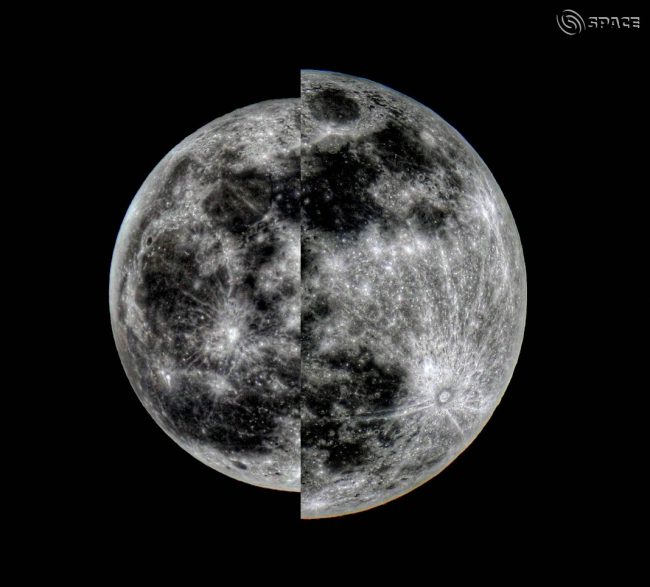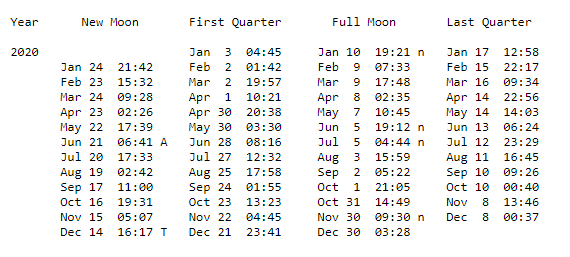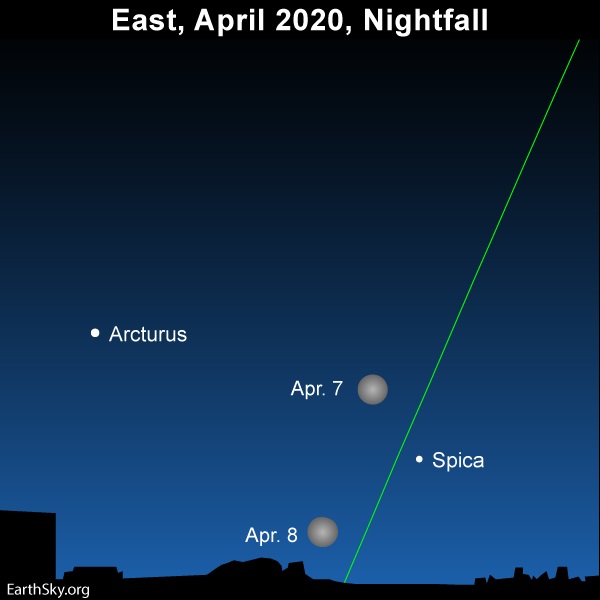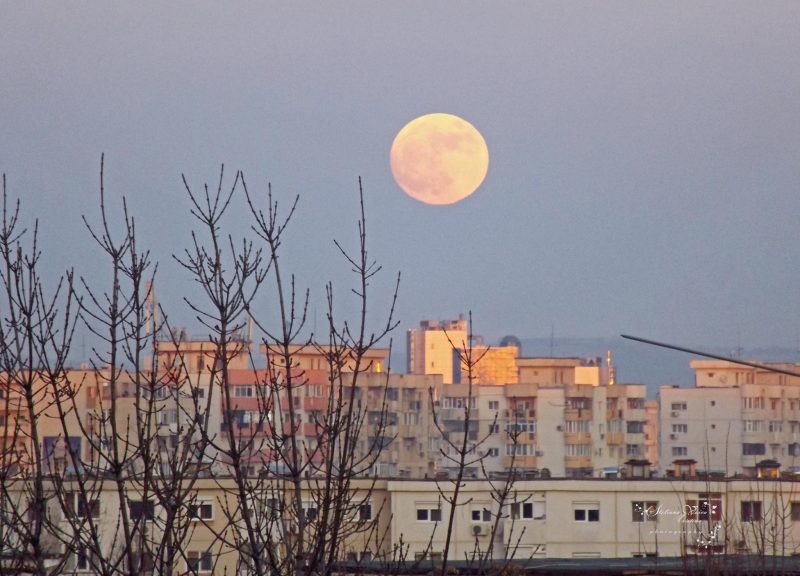
Above: Trish Minogue Collins’ photo of last’s year’s biggest supermoon on February 19, 2019, as the rising moon came up behind the Stargazer sculpture in a field at Manorville, New York.
In North America, we often call the April full moon the Pink Moon, Grass Moon or Egg Moon. In 2020, this April full moon also presents the closest (and thereby largest) supermoon of the year. This full moon more closely coincides with lunar perigee – the moon’s closest point to Earth in its monthly obit – than does any other full moon in the year 2020. Will you notice that the moon is larger than usual? Probably not … unless you’re a very experienced and discerning observer.
The angular diameter of a supermoon appears about 7% bigger than that of an average-size full moon, and about 14% bigger than the angular diameter of a micro-moon or mini-moon (year’s most distant and smallest full moon), perhaps not enough to be noticeable to most of us using the eye alone.
On the other hand, will you notice that the full moon of April 7-8 is particularly bright? Yes! Maybe … if you’re an observant moon-watcher. That’s because supermoons can be up to 15% brighter than an average-size full moon, and 30% brighter than a micro-moon.

Full moons at apogee, or farthest from Earth (left) and perigee or closest to Earth (right) in 2011. Composite image by EarthSky community member C. B. Devgun in India. Thanks, C. B.! Using the eye alone, it’ll be difficlt to notice any size difference in the full moon of April 7-8, 2020. But moon-watchers might notice that this is a very bright full moon! Plus Earth’s oceans will feel an extra pull.
We give the distances (as measured between the centers of the moon and Earth) for the the April 2020 lunar perigee and full moon:
April lunar perigee (221,773 miles or 356,909 km): April 7, 2020 at 18:08 UTC
April full moon (221,851 miles or 357,035 km): April 8, 2020 at 2:35 UTC
The moon comes closest to the Earth for the entire year when it reaches perigee on April 7, 2020, at 18:08 UTC (translate UTC to your time zone). Of this year’s 13 lunar perigees, this is one of only two lunar perigees that comes closer than 221,830 miles (357,000 km). The other close lunar perigee (356,912 km or 221,775 miles) falls on October 16, 2020, approximately 3 1/2 hours after the October 16 new moon.

The moon phases in the year 2020 via Astropixels. A = annular solar eclipse, T = total solar eclipse, and n = penumbral lunar eclipse. The year 2020 has 13 full moons, two of which take place in the month of October.
M = year’s farthest perigees and apogees, and m = year’s closest perigees and apogees. Table via Astropixels.
The bright star near the moon on April 7 and 8 is Spica, the constellation Virgo’s one and only 1st-magnitude star. April full moons always take place in front of the constellation Virgo the Maiden; they signal the arrival of spring in the Northern Hemisphere and autumn in the Southern Hemisphere.
This April full moon is the first of the season’s three full moons to fall in between the March equinox and the June solstice.
Click on Heavens-Above to find out the moon’s position in front of the constellations of the zodiac.

The April full moon swings between the Northern Hemisphere’s 2 bright springtime stars, Arcturus and Spica. In the Southern Hemisphere, these 2 brilliant stars are fixtures of the season of autumn.
The moon will appear full to the eye on both April 7 and 8. Astronomically speaking, though, the moon is said to be full at a well-defined instant: when the moon is 180 degrees opposite the sun in ecliptic longitude. This month, the full moon instant will arrive on April 8 at 2:35 UTC. At time zones in the U.S., the moon will turn precisely full on the evening of April 7 at 10:35 p.m. EDT, 9:35 p.m. CDT, 8:35 p.m. MDT, 7:35 p.m. PDT, 6:35 p.m Alaskan Time and 4:35 p.m. Hawaiian Time. Translate UTC to your time.
In other words, the moon reaches its full phase when the moon-sun elongation equals 180 degrees. Click on The Moon Tonight to find out the present moon-sun elongation, remembering that a positive number depicts a waxing moon and a negative number a waning moon.
So this April full moon showcases the biggest and closest full moon of 2020. In 2020, this April full moon is the one that most closely aligns with lunar perigee. Amazingly enough, 14 returns to full moon almost exactly equal 15 returns to lunar perigee. The mean lunar month (as measured from full moon to full moon) equals 29.53059 days whereas the mean anomalistic month (as measured from perigee to perigee) equals 27.55455 days.
Hence:
14 lunar months (14 returns to perigee): 14 x 29.53059 days = 413.43 days
15 anomalistic months (15 returns to perigee): 15 x 27.55455 days = 413.32 days
This 413-day period of time is the equivalent of about one year, one month and 18 days. Therefore, next year’s biggest supermoon will come on May 26, 2021. That’ll be 2021’s closest alignment between full moon and lunar perigee:
May 2021 lunar perigee (222,022 miles or 357,310 km): May 26, 2021, at 1:52 UTC
May 2021 full moon (222,116 miles or 357,461 km): May 26, 2021, at 11:14 UTC
Bottom line: Watch for the biggest full moon of 2020 to shine all night long on the night of April 7-8, 2020. The full moon will climb highest up for the night around midnight and set in the west around sunrise April 8.
Phases of the moon: 2001 to 2100
Moon at perigee and apogee: 2001 to 21000
Lunar perigee and apogee calculator
Top 4 keys to understanding moon phases
from EarthSky https://ift.tt/2JMXwlP

Above: Trish Minogue Collins’ photo of last’s year’s biggest supermoon on February 19, 2019, as the rising moon came up behind the Stargazer sculpture in a field at Manorville, New York.
In North America, we often call the April full moon the Pink Moon, Grass Moon or Egg Moon. In 2020, this April full moon also presents the closest (and thereby largest) supermoon of the year. This full moon more closely coincides with lunar perigee – the moon’s closest point to Earth in its monthly obit – than does any other full moon in the year 2020. Will you notice that the moon is larger than usual? Probably not … unless you’re a very experienced and discerning observer.
The angular diameter of a supermoon appears about 7% bigger than that of an average-size full moon, and about 14% bigger than the angular diameter of a micro-moon or mini-moon (year’s most distant and smallest full moon), perhaps not enough to be noticeable to most of us using the eye alone.
On the other hand, will you notice that the full moon of April 7-8 is particularly bright? Yes! Maybe … if you’re an observant moon-watcher. That’s because supermoons can be up to 15% brighter than an average-size full moon, and 30% brighter than a micro-moon.

Full moons at apogee, or farthest from Earth (left) and perigee or closest to Earth (right) in 2011. Composite image by EarthSky community member C. B. Devgun in India. Thanks, C. B.! Using the eye alone, it’ll be difficlt to notice any size difference in the full moon of April 7-8, 2020. But moon-watchers might notice that this is a very bright full moon! Plus Earth’s oceans will feel an extra pull.
We give the distances (as measured between the centers of the moon and Earth) for the the April 2020 lunar perigee and full moon:
April lunar perigee (221,773 miles or 356,909 km): April 7, 2020 at 18:08 UTC
April full moon (221,851 miles or 357,035 km): April 8, 2020 at 2:35 UTC
The moon comes closest to the Earth for the entire year when it reaches perigee on April 7, 2020, at 18:08 UTC (translate UTC to your time zone). Of this year’s 13 lunar perigees, this is one of only two lunar perigees that comes closer than 221,830 miles (357,000 km). The other close lunar perigee (356,912 km or 221,775 miles) falls on October 16, 2020, approximately 3 1/2 hours after the October 16 new moon.

The moon phases in the year 2020 via Astropixels. A = annular solar eclipse, T = total solar eclipse, and n = penumbral lunar eclipse. The year 2020 has 13 full moons, two of which take place in the month of October.
M = year’s farthest perigees and apogees, and m = year’s closest perigees and apogees. Table via Astropixels.
The bright star near the moon on April 7 and 8 is Spica, the constellation Virgo’s one and only 1st-magnitude star. April full moons always take place in front of the constellation Virgo the Maiden; they signal the arrival of spring in the Northern Hemisphere and autumn in the Southern Hemisphere.
This April full moon is the first of the season’s three full moons to fall in between the March equinox and the June solstice.
Click on Heavens-Above to find out the moon’s position in front of the constellations of the zodiac.

The April full moon swings between the Northern Hemisphere’s 2 bright springtime stars, Arcturus and Spica. In the Southern Hemisphere, these 2 brilliant stars are fixtures of the season of autumn.
The moon will appear full to the eye on both April 7 and 8. Astronomically speaking, though, the moon is said to be full at a well-defined instant: when the moon is 180 degrees opposite the sun in ecliptic longitude. This month, the full moon instant will arrive on April 8 at 2:35 UTC. At time zones in the U.S., the moon will turn precisely full on the evening of April 7 at 10:35 p.m. EDT, 9:35 p.m. CDT, 8:35 p.m. MDT, 7:35 p.m. PDT, 6:35 p.m Alaskan Time and 4:35 p.m. Hawaiian Time. Translate UTC to your time.
In other words, the moon reaches its full phase when the moon-sun elongation equals 180 degrees. Click on The Moon Tonight to find out the present moon-sun elongation, remembering that a positive number depicts a waxing moon and a negative number a waning moon.
So this April full moon showcases the biggest and closest full moon of 2020. In 2020, this April full moon is the one that most closely aligns with lunar perigee. Amazingly enough, 14 returns to full moon almost exactly equal 15 returns to lunar perigee. The mean lunar month (as measured from full moon to full moon) equals 29.53059 days whereas the mean anomalistic month (as measured from perigee to perigee) equals 27.55455 days.
Hence:
14 lunar months (14 returns to perigee): 14 x 29.53059 days = 413.43 days
15 anomalistic months (15 returns to perigee): 15 x 27.55455 days = 413.32 days
This 413-day period of time is the equivalent of about one year, one month and 18 days. Therefore, next year’s biggest supermoon will come on May 26, 2021. That’ll be 2021’s closest alignment between full moon and lunar perigee:
May 2021 lunar perigee (222,022 miles or 357,310 km): May 26, 2021, at 1:52 UTC
May 2021 full moon (222,116 miles or 357,461 km): May 26, 2021, at 11:14 UTC
Bottom line: Watch for the biggest full moon of 2020 to shine all night long on the night of April 7-8, 2020. The full moon will climb highest up for the night around midnight and set in the west around sunrise April 8.
Phases of the moon: 2001 to 2100
Moon at perigee and apogee: 2001 to 21000
Lunar perigee and apogee calculator
Top 4 keys to understanding moon phases
from EarthSky https://ift.tt/2JMXwlP


Aucun commentaire:
Enregistrer un commentaire